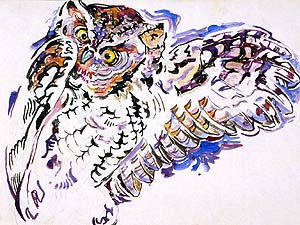|
Audio
Photos
|
 |
| Artist Walter Anderson is often credited with giving his animal subjects personalities and moods, as in this study of an owl. (Image courtesy of Bell Museum of Natural History) |
Minneapolis, Minn. — Artist Walter Anderson was born in New Orleans, but spent most of his life along the gulf coast of Mississippi. From the 1930's right up to his death in 1965, Anderson painted the plants and animals of the coastline.
In some pieces his work evokes the patterns and geometry of MC Escher, in others the vivid colors of Vincent Van Gogh. He once said "everything I see is new and strange."
Pat Pinson, curator of the Walter Anderson Museum of Art in Mississippi, says Anderson was a brilliant, reclusive, troubled man. She says he had a unique relationship with nature, particularly the nature of Horn Island, off the coast of Mississippi. He spent weeks there exposed to the extremes of hot and cold. He even stayed on the island during Hurricane Betsy, despite the best attempts of local fishermen to bring him in.
"He went to the highest point on the island and tied his boat to a tree, and tied himself also there to where he could watch the storm," says Pinson. "He lived through it, and after the storm was over, well here come the boats again wanting to see if he was still alive. He was, but he was still not ready to go home."
Pinson says Anderson once attempted to share his peculiar vision of the natural world with his wife.
"He loved the water, and one time he held her underwater until she thought she was going to drown because he wanted her to experience what the watery medium was like," says Pinson.
Such behavior landed Anderson in mental hospitals off and on for several years. In the late 1940's he left his family to lead a solitary existence, and spent the next 18 years making regular trips out to Horn Island. He never had been interested in selling or showing his work; after he died it was found in his cabin piled up in drifts. The work was divided between the family and what became the Walter Anderson Museum of Art.
Don Luce curates exhibits at the Bell Museum of Natural History on the University of Minnesota campus. He says showing Anderson's art at a natural history museum makes sense if it makes people see the natural world in a new way.
"I think when you look at his paintings - they're so fresh - it's almost like he's seeing this for the first time," says Luce. "And to get people to see something, really see something - like they're just discovering it for the first time - that is the essence of both real artistic genius and real science."
Luce has placed some of Anderson's paintings next to specimens from the museum's collection to highlight that relationship. Elizabeth Max came in from Brooklyn Park for the exhibit opening. She's been a fan of Walter Anderson's work ever since she travelled to Biloxi Mississippi with her parents when she was a kid. She has an entire room filled with reproductions of his work.
"I like the way he captures everything," says Max. "He kind of gets to inner personalities or his idea of what an inner personality of an animal is."
Max says she was surprised to learn Anderson's artwork was coming to the Bell Museum, since he's not well known outside of the south.
Curator Pat Pinson is out to change that. This past summer, another hurricane, Katrina, came calling. Pinson says it flooded the Anderson family vault, where hundreds of his works were stored.
"The vault was built three feet above Hurricane Camille levels," says Pinson. "It has a three foot thick wall and two steel doors, so they thought it was going to be safe. But those steel doors looked like somebody had rammed them."
Pinson says the inside of the family vault looked like a washing machine; papers strewn everywhere, soaking wet. In comparison, the Walter Anderson Museum of Art was lucky - the building sustained only minor water damage.
But now the museum faces another problem. Pinson doesn't expect much tourism along the Gulf Coast for at least the next year, and over half of the museum's income comes from entrance fees and gift shop sales. But she says the museum must stay open:
"This museum is the only museum that's open on the Mississippi Gulf Coast," says Pinson. "It is the only that is able to open and we see that it's our mission that we need to be there and establish some sense of normalcy for everyone else."
Pinson says touring Anderson's work to places like the Bell Museum is now more important than ever. It generates income for the museum, and creates interest in people around the country to come visit Ocean Springs, Mississippi and see more of Walter Anderson's work.








